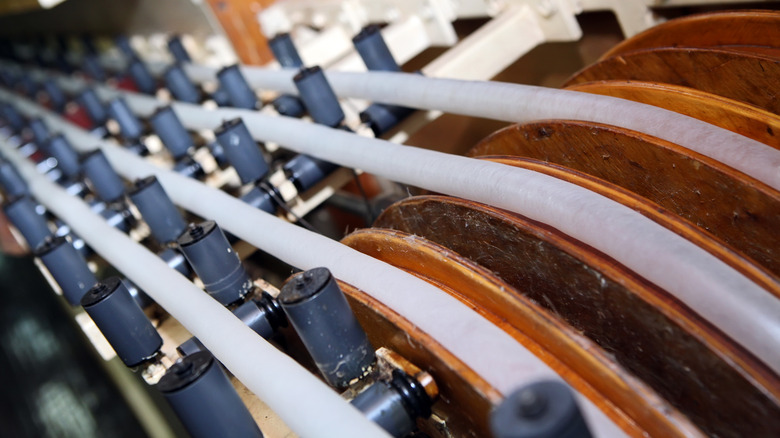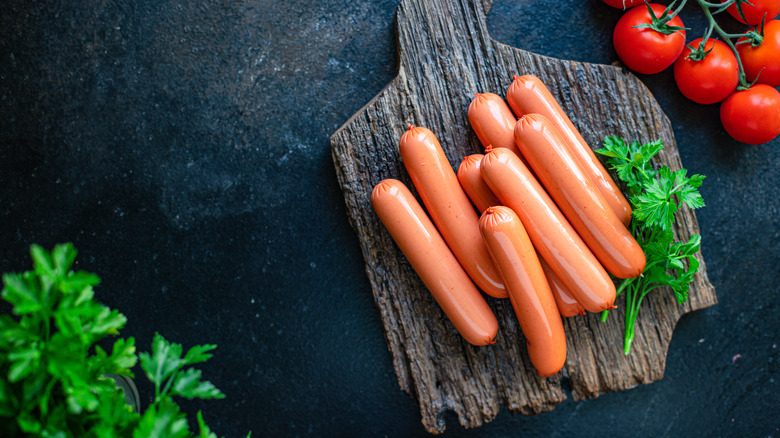What Sausage Casings Are Made Of, Natural Or Synthetic
If you're a squeamish eater, there's a good chance you may have been a little freaked out when you found out that casings (that is, the covering) for sausages are made with intestines. However, that's not the whole story — there are a variety of sausage casings out there now, including synthetic options, usually made with collagen from animals. There are even plant-based casings on the market (although these are obviously mostly used for vegan "sausage" products).
But first, the intestine question: Historically, sausages were encased inside the intestines of animals like pigs, sheep, and cows, and there's evidence to suggest that this has been the case for a few millennia. The intestines are cleaned thoroughly beforehand, and impart more of a meaty flavor once the sausage has been cooked. It's usually the submucosa layer that's used, because its higher collagen content helps keep the sausage firmly intact. It's also usually salted before the sausage meat is squeezed into it. Nowadays, this is described as "natural" casing, but if you're buying sausages from the supermarket, chances are you're not going to encounter this variety. Mass-produced sausages mostly use synthetic casings, because it's cheaper, although butchers still use natural casings sometimes. If you're unsure, just ask.
What about synthetic sausage casing?
There's two types of synthetic casing out there — edible and inedible. The edible ones are typically made with collagen that comes from animal hides (cows and pigs, generally speaking). To create these, the collagen is extracted from the hide, dried, and pressed flat. They're cheaper to produce than natural casings and give sausage makers greater control over the size and shape of a sausage. However, they're sometimes regarded as lesser when it comes to flavor. (If you're trying to spot the difference, naturally-cased sausages will usually have more varied shapes, since intestines don't all look identical, while synthetic sausages will usually look pretty uniform.)
Sausages like bologna, salami, and pepperoni may use inedible synthetic casings, which are sometimes called fibrous casings. They're made with cellulose, a substance found in wood and cotton, which is somewhat porous and allows the sausages to be steamed or smoked in the casing. And don't worry about accidentally eating inedible casing: the U.S. Department of Agriculture requires that packages be clearly marked with instructions on how to remove them.
New on the market: plant-based sausage casings
For companies that make vegan or vegetarian sausages, the main types of natural and synthetic casings are obviously unsuitable — intestines are most certainly not vegetarian, and the collagen used for edible synthetic casing also comes from animals. So, enterprising inventors have devised alternatives. One popular way to make plant-based casings is with polysaccharide, a carbohydrate that, when mixed with water and glycerin, forms a starchy casing that's totally edible (and should be both vegan- and vegetarian-friendly).
Some companies, including Beyond Meat, have started using alginate, which is a type of polysaccharide that comes from seaweed. Interestingly, alginate is also starting to be used as a synthetic casing for meat sausages as well. While a vegetarian casing for meat sausages might seem redundant, it turns out that it's cheaper and less work-intensive to make alginate casings than the "classic" synthetic collagen ones. It's also easier for halal and kosher sausage-makers since they don't need to worry about which animal the synthetic casing was derived from.


